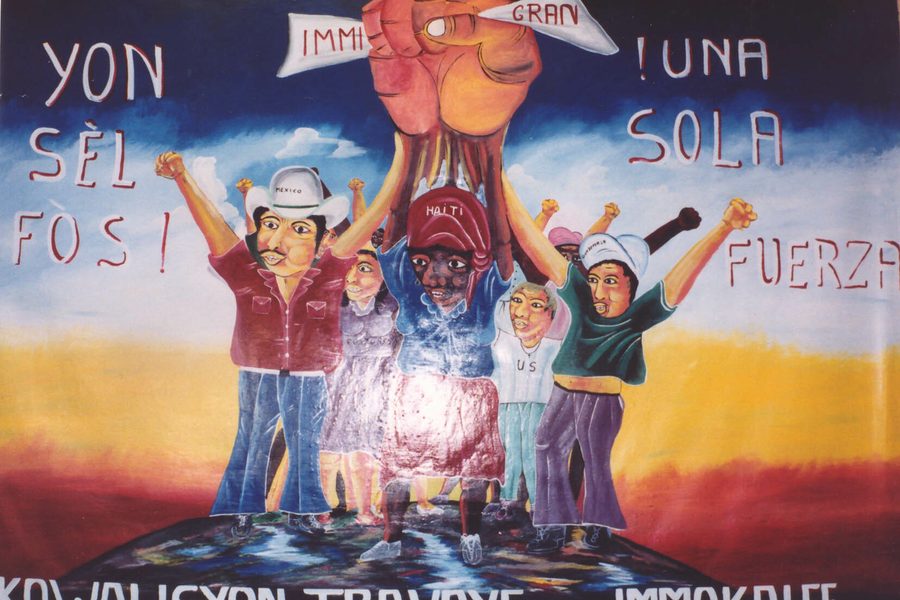
As U.S. unions and workers struggle to gain or protect living-wage jobs, benefits and the right to organize, it is easy to forget that thousands of workers in this country not only don’t enjoy such basic labor rights, but are actually working quite literally in slavery.
One grassroots group, the Coalition of Immokalee Workers, has single-handedly pushed the issue of slavery into public consciousness during the past decade, raising awareness with nationwide campaigns and working with prosecutors to break up human slavery rings.
Their latest and perhaps most visceral contribution is the Florida Modern Day Slavery Museum, a brand-new traveling exhibit housed in a replica of the 24-foot cargo truck where workers were kept in captivity and forced to labor picking tomatoes in south Florida.
Workers were held for two and a half years in the sweltering, fetid truck, where they slept, defecated and urinated between shifts in the fields. They finally escaped in 2007 by punching a hole through the roof. Two brothers were convicted last year and sentenced to 12 years in federal prison for the crime.
The coalition notes that even though slavery
convictions have become more common in recent years, punishment is
still generally relatively light and traffickers are likely to go back
to the trade upon their release.
The museum features
real-life artifacts, including a bloody shirt worn by a worker beaten
for picking too slowly, the 32-pound baskets of tomatoes for which
workers earn less than 50 cents for filling, and chains used to prevent workers
from fleeing. The museum highlights slavery’s long history in Florida,
from the African slave trade to black chain gangs to enslavement of poor whites during the depression … to today’s
slavery rings, which prey on mostly undocumented, uneducated immigrants
from southern Mexico, Guatemala and other parts of Latin America.
More than 1,000 people have been freed from literal slavery in the past decade, thanks in large part to the CIW aiding federal investigators, often going undercover to gather evidence.
Workers are typically trafficked by rings – often run by Latin American immigrants themselves – who promise decent jobs to residents of rural, desperately impoverished and often indigenous communities in Latin America. Upon arriving in the United States, they are often literally held under guard, prevented from leaving the fields or their filthy overcrowded housing.
Whether or not they are held under guard, they are also prevented from leaving because of exorbitant and inescapable fees charged by traffickers and ridiculously high rents charged by employers or associates in the U.S. They are likely to have put up homes or property at home to cover the debt, putting their families in danger if they flee.
In a story for the now-defunct Gourmet published early last year – a story quite different from the magazine’s usual fare – Barry Estabrook described how Mariano Lucas Domingo was held captive in the truck:
Lucas’s “room” turned out to be the back of a box truck in the junk-strewn yard, shared with two or three other workers. It lacked running water and a toilet, so occupants urinated and defecated in a corner. For that, Navarrete docked Lucas’s pay by $20 a week. According to court papers, he also charged Lucas for two meager meals a day: eggs, beans, rice, tortillas, and, occasionally, some sort of meat. Cold showers from a garden hose in the backyard were $5 each. Everything had a price. Lucas was soon $300 in debt. After a month of ten-hour workdays, he figured he should have paid that debt off.
But when Lucas — slightly built and standing less than five and a half feet tall — inquired about the balance, Navarrete threatened to beat him should he ever try to leave. Instead of providing an accounting, Navarrete took Lucas’s paychecks, cashed them, and randomly doled out pocket money, $20 some weeks, other weeks $50. Over the years, Navarrete and members of his extended family deprived Lucas of $55,000.
Taking a day off was not an option. If Lucas became ill or was too exhausted to work, he was kicked in the head, beaten, and locked in the back of the truck. Other members of Navarrete’s dozen-man crew were slashed with knives, tied to posts, and shackled in chains. On November 18, 2007, Lucas was again locked inside the truck. As dawn broke, he noticed a faint light shining through a hole in the roof. Jumping up, he secured a hand hold and punched himself through. He was free.
The slavery museum debuted February 28 in Fort Myers for a six-week Florida tour, including stops in Naples, Venice and Sarasota (see the schedule and more information here). Then it will accompany the Immokalee Workers and hundreds of supporters on a Freedom March held April 16-18 from Tampa to the Lakeland, Fla. headquarters of the grocery chain Publix Super Markets Inc.
The CIW has attacked slavery and generally abominable and unjust working conditions in southern farms largely by targeting the restaurants and grocery stores that buy the tomatoes picked by workers in slavery or otherwise highly exploitative and unhealthy conditions.
Their first target was Taco Bell and parent company Yum! Brands, with whom they secured a groundbreaking workers’ rights agreement after several years of national marches, boycotts and campaigns on college campuses. After that landmark victory, agreements with major corporations — including McDonald’s, Whole Foods, Burger King and Subway — came faster.
Kari Lydersen is a Chicago-based journalist, author and assistant professor at Northwestern University, where she leads the investigative specialization at the Medill School of Journalism, Media, Integrated Marketing Communications. Her books include Mayor 1%: Rahm Emanuel and the Rise of Chicago’s 99%.








